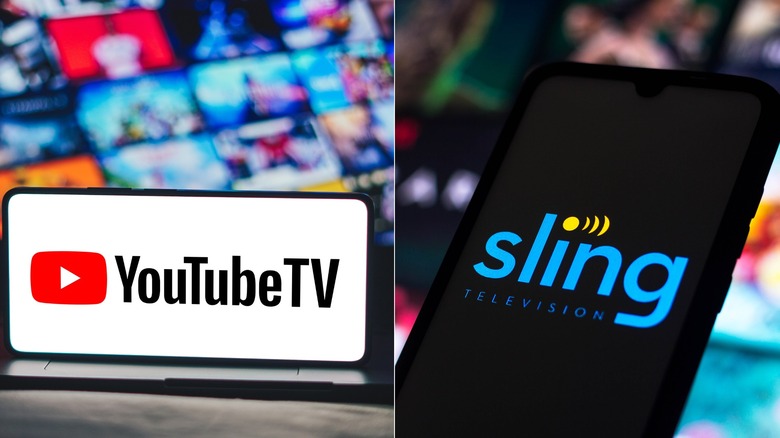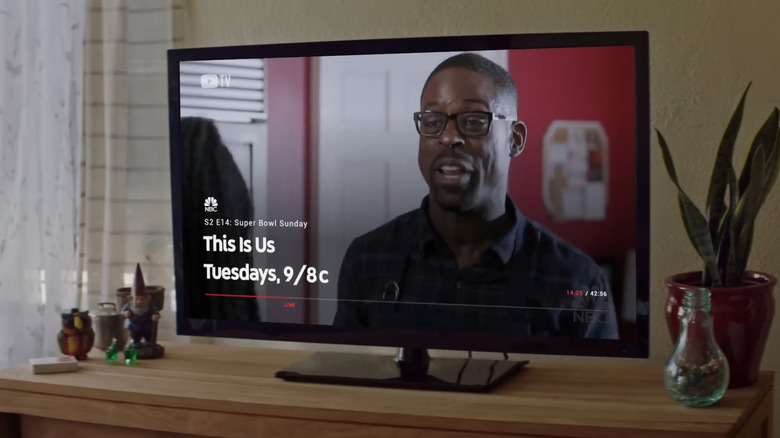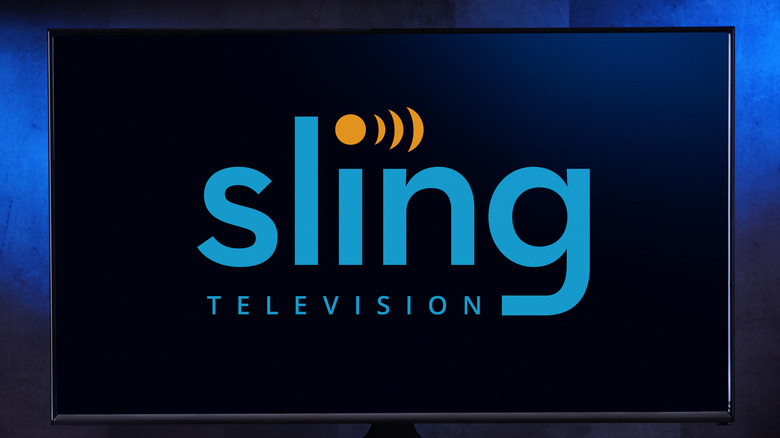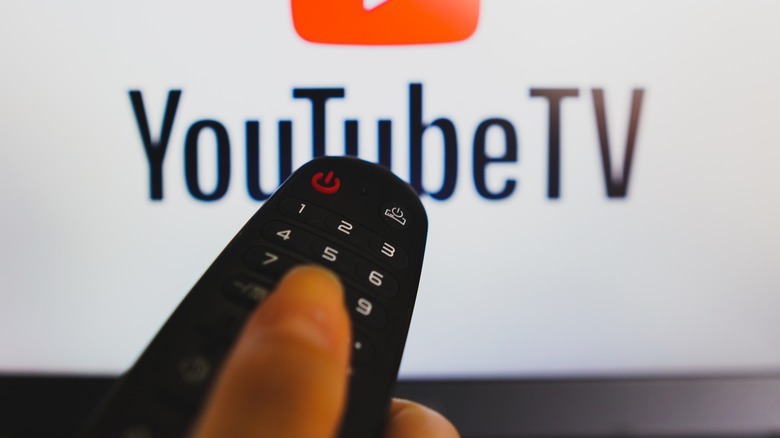YouTube TV Vs. Sling TV: Which Is Better In 2024?
No matter how easy streaming services such as Netflix and Disney+ make it for us to watch our favorite movies and shows, there's still no comparing to the experience that comes with watching live TV for many of us. It's never been easier to scratch that itch nowadays, as there's no shortage of quality live TV streaming services to choose from. Likewise, it's easy to want to pit these services against one another as you pick one that's best for you or make a recommendation. Two platforms you often see compared with one another are YouTube TV and Sling TV.
At first glance, it's easy to see what would make both services comparable. Each offers a wide variety of popular live TV channels, can be watched on most common devices, and offer extended options for add-ons and extra features. But as you can imagine, there are a multitude of nuanced differences that come with each service, and it's important to take note of them before signing up for one.
I've personally had experience using a wide array of live TV streaming services in the past and was able to try out YouTube TV and Sling TV for the purposes of this article. This, along with additional research, went into making this comparison piece, where we'll be diving deep into the channels, layout, pricing, and additional features that each service has to offer to help you choose the best one for you.
Channels and add-ons
As a whole, YouTube TV has more to offer in terms of channel selection by a significant margin. The base subscription gets over 100 live channels, which even tops the more expensive Hulu+ Live TV, which has roughly 90 channels. YouTube's offerings include news networks such as ABC, FOX, CBS, NBC, and CNN, sports channels such as ESPN, the Golf Channel, NBA TV, and the NFL Network, and entertainment channels including FX, Comedy Central, Freeform, and TBS. The service also includes a host of on-demand content, from hit TV shows such as "NCIS" to major movies within the "Marvel Cinematic Universe." There's also no shortage of entertainment and sports add-ons to choose from, including MGM+, NBA League Pass, Max, and NFL Sunday Ticket to name a few.
Sling TV gives you two subscription options with the Orange and Blue plan. With Orange, you get 34 channels with eight exclusive channels such as ESPN, Disney Channel, and FreeForm. The Blue Plan features 42 channels including 16 signature offerings such as Discovery, FX, MSNBC, FOX, and TLC. Users also have the option to combine both plans for a total of 48 channels, including all 22 exclusive networks. Many of Sling's add-ons come in economical bundle options, ranging from a Kids Extra package that includes Disney XD, Boomerang, and Nicktoons to a Sports Extra package including NBA TV, ESPN News, and more.
Along with having less channels, Sling TV also comes up short when it comes to serving up local channels. Whereas YouTube TV features regional networks such as PBS, Univision, and Telemundo within its base plan, you'll need a digital antenna to access these channels through Sling TV.
Layout and user experience
YouTube TV benefits from the proven success of YouTube's interface. The overall layout is breezy and well-organized, with tabs for your home screen, a library containing your DVR recordings, and all of your live channels. The home page lets you see programs you're still watching, recommended picks, and easy access to live news, sports, and on-demand content. I never experienced any significant challenges in going through channels or recording programs, although it is worth noting that, like regular YouTube, any kid's programming being watched will automatically pause if you try searching for anything else. While I didn't mind that the service is ad-supported, it would be nice if there was an ad-free option, as plenty of users would not mind paying extra for that.
With Sling TV, you get a bit more of a basic layout, which isn't necessarily a bad thing. It features tabs for your home page that gives you quick access to your content and recommendations, live channels, movies, sports, rentals, and a guide providing further channel details. One aspect that where it beat YouTube TV, at least in my opinion, was its picture-in-picture capabilities. Whereas YouTube TV hides your program at the top of the screen with only audio being heard, Sling is more like traditional YouTube. Where what you're watching simply gets smaller as you browse elsewhere, allowing you to still see and hear your program. Nevertheless, there's a bit more friction when it comes to accessing your DVR recordings, and it generally runs slower than YouTube TV.
Worth mentioning is that both services are compatible with most standard streaming players and devices, including Roku, Fire TV, Chromecast, Apple TV, iOS devices, Android, Xbox One, and PlayStation.
Plans and pricing
What's sure to be the ultimate deal-breaker for many are the costs that come with these services. In the case of YouTube and Sling TV, there are few live streaming examples that are at such drastically opposite ends of the spectrum.
The base plan for YouTube TV is currently $72.99 a month plus taxes, which, while pricey, is still cheaper than cable. This gives you access to over 100 channels, unlimited DVR storage for nine months, and the ability to stream on upwards of three devices at the same time. The many add-on options range in price from $3 to $30. YouTube TV also offers free trials of varying lengths, typically lasting for seven days.
Whether you go with a Sling TV Orange or Blue plan, you'll only be paying $40 a month, which provides you with 50 hours of DVR storage. With the Orange plan, you can stream on one device at a time, while Blue allows you to stream on three simultaneously. Combining both plans will have you pay $55 a month, and you can also upgrade to 200 hours of storage for an additional $5 per month. With add-ons, you'll be paying another $1.99 to $29.99. While the cheaper price may be a draw to some, it'll have to be something you're sure about, as Sling TV has no free trial option, although you can also sign up for Sling Freestream to get a taste of what the service has to offer.
Which is best?
At the end of the day, it's hard to go wrong with either YouTube TV or Sling TV. Ultimately, your choice will depend on what you want out of your service and the limitations you can tolerate.
For those seeking a premium option or only want to use one service, YouTube TV is perhaps your best bet. It offers more channels, has a more streamlined user interface, and possesses more options and storage space for recording content. While it's more expensive, you get plenty of bang for your buck with what the service has to offer. I also personally had a lot of fun exploring the variety of on-demand content available on the platform.
Meanwhile, Sling TV still delivers a quality experience and is especially well-suited for those on a tighter budget. It could also be a good one to have if used in conjunction with other low to no cost live streaming services such as Pluto TV and Peacock, allowing you to have a wider net of channel options.




